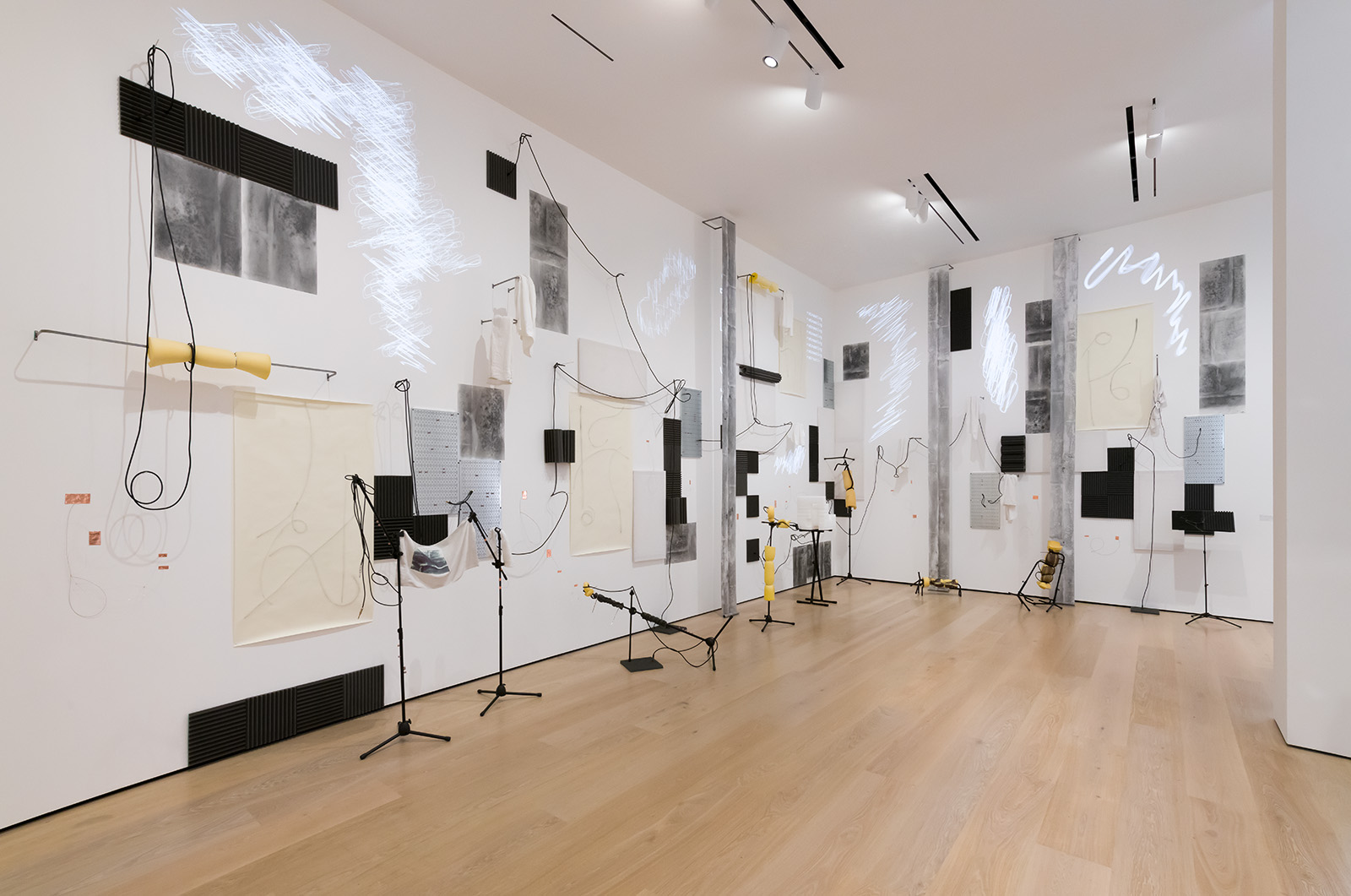Artist considers intersections of rock ’n’ roll and protest in installation

Alumna Nikita Gale’s “Proposal: Soft Surround System” is on display until Sept. 2 at the Hammer Museum as part of the “Made in L.A.” series. Gale said she was inspired by rock ’n’ roll music as well as the connections people have with their social and political environments while making art. (Courtesy of Jeff McLane/56 Henry)
Made In L.A.
Hammer Museum
Now through September 2
By Haley Tangen
Aug. 13, 2018 12:08 a.m.
Alumna Nikita Gale used a theory found in The Beach Boys’ music to inspire her current exhibition at the Hammer Museum.
The theory involves taking one note and repeating it in a multitude of voices, making it sound more forceful than it would with just a single voice, she said.
Gale’s artwork, titled “Proposal: Soft Surround System,” is part of the Hammer Museum’s 2018 “Made in L.A.” series, which highlights local artists and is on display until Sept. 2. Her initial inspiration for the installation, the album “The Hope Six Demolition Project” by PJ Harvey, sparked an interest in the history of rock ’n’ roll music, which she chose to explore through art.
“I was reminded of this power or the way that music and sound can be this powerful galvanizing force on a very intuitive and visceral level,” she said.
Erin Christovale, assistant curator at the Hammer, said the most interesting aspects of Gale’s exhibit are the inclusion of sound materials and static imagery to convey the idea of sound without any actual sound. For example, the visual art piece includes light projections of drawings like squiggly lines that represent sound. The exhibit features pieces made of materials that could be found in a do-it-yourself music studio, including music stands, copper tape for guitar repair and sound-dampening panels made of towels.
“You get this very visceral sort of response to sound that you don’t actually get to experience (in the exhibit),” Christovale said.
Gale’s gallerist Ellie Rines, who featured Gale’s work in the New York gallery 56 Henry, said Gale first picks an object to focus on. From there, she is able to figure out its essence and the connotations the object has about today’s society. In the case of a towel, Gale looks at it as an extension of the human experience because the towel conjures a feeling of touch. In the “Made in L.A.” exhibit, her objects connect to the idea of music as reflective of the political and culture environments.
“She really delves into an object, investigates it and is able to take something that’s kind of sitting there and really delve into it to where she starts to find it has characteristics or that it can take action or have agency,” Rines said.
The objects Gale uses in her exhibit suggest sound without actually creating sound. Gale said she also took inspiration from the connections that people have with their social and political environments, and how objects are representations and extensions of those relationships. Her undergraduate background in archaeology taught her that objects removed from their physical environment can take on different functions. For example, the music stand in her exhibition is still a music stand but is used to hold objects other than music sheets. By incorporating these objects, Rines said Gale is able bring her viewers’ attention to them, whereas they may not give them attention otherwise.
The inclusion of guitar strings in the exhibit demonstrates the relationship between people and their environments because music is a big part of culture and allows people to express themselves, she said. The guitar strings show up alongside objects like boom microphone stands.
“I was thinking about the guitar in terms of how it amplifies gesture and becomes a kind of a mode of performativity or personal expression and an extension of cultural expression,” Gale said.
A form of expression she wanted to explore in her work was protest, including exploring which types of protest felt relevant to her and which didn’t. In her research into the history of rock ’n’ roll, she felt that it was a type of protest she could relate to because of a song’s ability to safely broadcast dissent. In contrast, she did not relate to the street protests following President Donald Trump’s election because it seemed more like people were seeking personal catharsis instead of protesting in hopes of actual change. She said rock ’n’ roll has its origins in blues and was a form of protest for marginalized groups.
“People from marginalized and oppressed groups can pretty safely express some pretty strong opinions about things if they were expressed in a song,” Gale said. “So much music is a double entendre.”
The inclusion of rock ’n’ roll elements is not the only way Nikita’s exhibit expresses her feelings about protest. Something that interests Christovale about Gale’s work is the inclusion of text. One element of the exhibition is a projection which flips between the words “retreating” and “resisting.” Protest is not just about resisting, but also what happens before and after the protest and being able to decompress, Christovale said.
“Those two terms (capture) the notion of protest in that protest is not just a physical action that takes to the street with a collective group of people,” Christovale said. “It’s sort of knowing when to step out in the street but also knowing when to create solitude for yourself.”
Gale said her work was a reaction to a political environment that leaves people feeling overwhelmed. She said her art is a way to express dissent that feels relevant.
“The work is really kind of a reaction to the sense that I’m feeling personally and that I imagine a lot of people are feeling right now … feeling like I just needed a sign, just a quiet moment or a quiet space to just process.”


